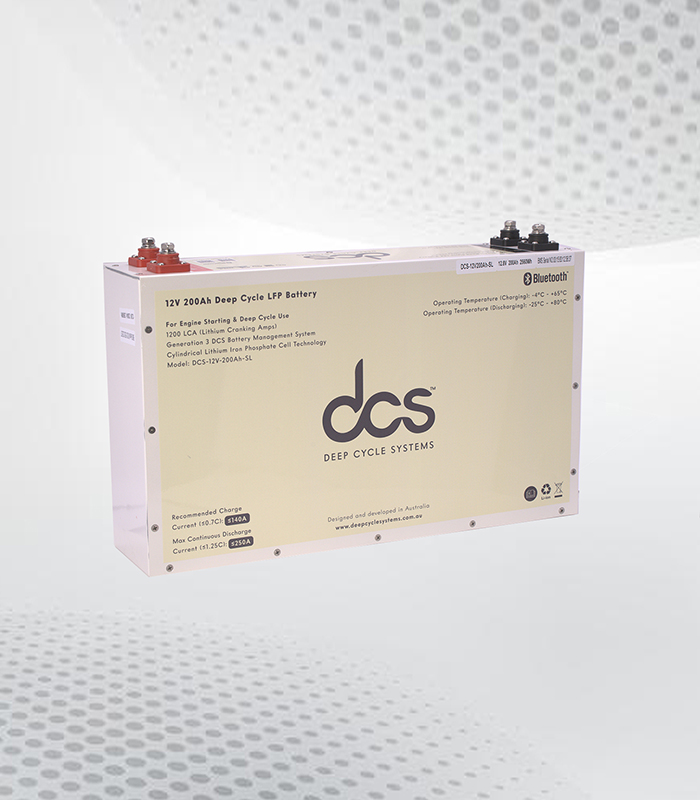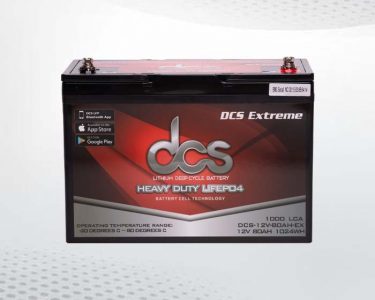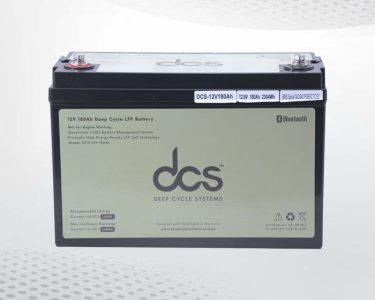The batteries are commonly used in recreational vehicles, boats, and solar energy systems due to their high storage capacity and ability to withstand deep discharges. However, many people may not be familiar with the specifics of these batteries and how to use and maintain them properly. In this blog post, we will provide a detailed guide on 200ah Deep Cycle batteries, covering everything from their basic components to how to choose the right one for your needs. By the end, you will better understand these powerful batteries and be equipped with the knowledge to make the most out of them.
Understanding the Basics of 200Ah Deep-Cycle Batteries
200Ah deep-cycle batteries are a pivotal component in off-grid power systems, offering a blend of durability and high-capacity energy storage. The term ‘200Ah’ refers to the battery’s ampere-hour rating, indicating that it can deliver 200 amps of current for one hour or a proportional amount over a different period, such as 20 amps for 10 hours.
This capability makes them exceptionally suitable for applications requiring a steady power supply over extended periods, unlike starter batteries designed to deliver short, high-current bursts. Deep-cycle batteries are characterised by their ability to be discharged and recharged repeatedly, with a typical deep-cycle battery that can withstand hundreds of these cycles during its lifespan.
This endurance is attributed to their thick plate design, which differs significantly from the thinner plates found in regular car batteries. This design allows for repeated discharge and charge cycles without significant degradation of the battery’s internal components. Understanding this fundamental operational principle is crucial for anyone looking to implement a 200Ah deep-cycle battery in their power setup, ensuring they can harness its full potential sustainably and efficiently.
The Benefits of Choosing a 200ah Deep Cycle Battery
Opting for a 200Ah deep-cycle battery presents many advantages, especially for those requiring a reliable and robust power source over prolonged periods. One significant benefit is its sheer capacity, enabling users to operate high-demand electrical devices and systems without frequent recharging.
This is particularly beneficial in off-grid setups or during extended outdoor activities, where access to conventional charging facilities is limited. Moreover, their ability to withstand numerous deep discharge cycles without substantial degradation ensures a longer service life, providing a cost-efficient solution.
Additionally, the versatility of 200ah Deep Cycle Battery makes them compatible with a wide range of applications, from renewable energy storage systems to emergency power backups, enhancing their practicality for domestic and commercial users. Their robustness and reliability under varying environmental conditions further underscore their suitability for challenging applications, offering peace of mind to users reliant on uninterrupted power supply. By integrating a 200Ah deep-cycle battery into your energy setup, you benefit from an optimal blend of performance, durability, and adaptability, meeting your power needs with unmatched efficiency.
Types of 200Ah Deep-Cycle Batteries
When exploring options for 200Ah deep-cycle batteries, you will encounter several key types, each with distinct advantages and best use cases. The primary categories include lead-acid, lithium-ion, and sealed lead-acid, encompassing AGM and Gel batteries.
Lead-acid batteries, a long-standing choice in the market, offer affordability and reliable performance, making them suitable for a broad range of applications. They do, however, require regular maintenance to ensure longevity. Lithium-ion batteries represent the forefront of battery technology, with a higher energy density, lighter weight, and longer lifespan. These attributes make them an excellent choice for applications where performance and space efficiency are critical.
Sealed lead-acid batteries, including AGM and Gel types, provide a maintenance-free solution, ideal for installations where regular upkeep is challenging. These batteries are known for their durability and safety, featuring a design that minimises the risk of leaks and is tolerant of varied environmental conditions. Each type of 200Ah deep-cycle battery serves distinct purposes, catering to the specific needs of users. Understanding the differences is crucial to selecting the most appropriate battery for your requirements, ensuring optimal performance and longevity of your power system.
Lead-Acid Deep-Cycle Batteries
Lead-acid deep-cycle batteries are a stalwart in high-capacity energy storage, celebrated for their cost-effectiveness and widespread accessibility. These units necessitate periodic maintenance to sustain peak performance, including monitoring water levels and ensuring they’re housed in well-ventilated environments to prevent overheating.
Their enduring presence in the market is a testament to their reliability and affordability, making them an excellent choice for numerous traditional energy-dependent setups. Despite the advent of advanced battery technologies, lead-acid batteries maintain a strong foothold in applications where initial cost and proven performance are paramount.
Lithium-Ion Deep-Cycle Batteries
Lithium-ion deep-cycle batteries are distinguished by their superior energy density and longevity, surpassing the performance of traditional lead-acid counterparts. This advanced battery technology ensures a compact, lightweight design, enabling more efficient storage and portability without sacrificing power. These batteries exhibit a lower self-discharge rate, enhancing their suitability for long-term applications.
Although the initial investment may be higher, lithium-ion variants’ extended lifecycle and reduced maintenance requirements present a cost-effective solution over time. They are particularly advantageous in applications demanding a high energy output and space efficiency, making them an ideal choice for modern, energy-intensive needs.
Sealed Lead-Acid Deep-Cycle Batteries
Sealed lead-acid deep-cycle batteries, encompassing both AGM (Absorbent Glass Mat) and gel types, offer a robust, maintenance-free option for energy storage. Unlike their flooded lead-acid counterparts, these batteries encapsulate the electrolyte, eliminating the need for regular top-ups of distilled water.
This feature renders them highly suitable for use in environments where minimal maintenance is a priority, such as in remote installations or applications where regular battery upkeep is not feasible. Their sealed nature also significantly reduces the risk of leaks or spills, making them a safer choice in sensitive or hard-to-reach locations. With a construction that tolerates a range of temperatures and conditions more effectively than non-sealed batteries, they represent a reliable choice for powering various applications, from renewable energy systems to backup power sources.
How to Calculate Your Power Needs
Calculating your power needs is critical in ensuring you select a 200Ah deep-cycle battery that meets your requirements effectively.
First, list all the electrical devices you plan to power with the battery, noting their wattage or the amount of power they consume. If the device specifications only mention amps, convert this to watts by multiplying by the system’s voltage (usually 12V, 24V, or 48V for deep-cycle applications). For example, a device drawing five amps on a 12V system uses 60 watts (5A x 12V = 60W). Next, determine the duration each device will operate daily, which allows you to calculate the total watt-hours (Wh) needed. For instance, a 60W device running for 5 hours daily will consume 300Wh (60W x 5h = 300Wh). Sum the daily consumption of all devices to get your total daily watt-hour requirement.
However, it’s prudent to include a margin of safety to account for inefficiencies and unexpected power needs, typically adding 20-25% to your total watt-hours. This adjusted figure gives you a more realistic estimation of your daily power needs. Finally, considering the 200Ah deep-cycle battery, remember it’s not advisable to deplete it fully. Deep-cycle batteries are often used to a depth of discharge (DoD) of about 50% for optimal longevity.
Therefore, if you have calculated a daily need of 1000Wh, with a system voltage of 12V, your battery should provide double this capacity to safely cover your needs without exceeding the recommended DoD. In this example, you’d need a battery capable of supplying 2000Wh daily (1000Wh / 0.5 DoD = 2000Wh), translating to approximately 166Ah (2000Wh / 12V = 166.67Ah), suggesting that a 200Ah battery would be suitable for this application.
Maintenance and Care for Your 200Ah Battery
Ensuring the enduring performance of your 200Ah deep-cycle battery involves diligent maintenance. Regular inspections for signs of wear or damage are paramount. Keeping the terminals clean is crucial to prevent corrosion, which can hinder battery efficiency.
Adherence to the charging guidelines provided by the manufacturer cannot be overstated; incorrect charging can significantly reduce the battery’s lifespan. Also, be mindful of the storage conditions; a cool, dry environment is ideal for prolonging the battery’s life. Implement these care practices to maintain optimal battery health and functionality.
Cleaning and Inspection Procedures for 200ah Battery Deep Cycle
Regular cleaning and inspection are essential to ensure the longevity and efficiency of your 200ah Battery Deep Cycle. Start by disconnecting the battery from any power source and removing any connections. Use a soft brush or cloth to remove dirt or debris from the battery’s surface gently.
Check the terminals for signs of corrosion, which can manifest as a white or greenish powder. If corrosion is present, create a paste using bicarbonate of soda and water, apply it to the affected areas, and scrub gently with a soft brush until the corrosion is removed. After cleaning, rinse the terminals with clean water and dry thoroughly. Inspect the battery casing for cracks, bulges, or leaks, as these can indicate internal damage or failure. Ensure the vent caps are securely in place and clear of obstructions for proper ventilation.
Tighten any loose connections and apply a thin layer of petroleum jelly to the terminals to prevent future corrosion. Perform these inspections and cleaning procedures regularly, particularly if the battery is exposed to harsh conditions or frequent deep discharges. This proactive approach will help identify potential issues before they escalate, safeguard the battery’s performance, and extend its service life.
Temperature Management Tips
Effective temperature management is vital for maximising the performance and lifespan of your 200Ah deep-cycle battery. These batteries are sensitive to extreme temperatures, with high and low temperatures potentially affecting their efficiency and capacity. To mitigate these risks, always install your battery in a location within the manufacturer’s recommended temperature range.
Consider installing a cooling system or ensuring adequate ventilation around the battery to dissipate heat effectively in environments prone to high temperatures. Insulation can help maintain an optimal operating temperature for cold climates, preventing the battery from becoming too cold. However, it’s crucial to ensure that any insulation allows for adequate air circulation to avoid overheating.
Additionally, avoid exposing the battery to direct sunlight for prolonged periods, which can significantly increase its temperature. If the battery is used in a mobile setup, such as in a caravan or boat, ensure it’s positioned in a shaded or insulated area to protect it from temperature extremes. These temperature management strategies will help safeguard your battery against temperature-related performance degradation and provide a longer, more reliable service life.
Handling and Transportation Guidelines
When transporting or handling your 200Ah deep-cycle battery, ensure it remains upright to prevent leakage of any internal components. Use protective gloves and eyewear to safeguard against potential acid spills. Always secure the battery firmly during transportation to avoid shifts that could cause short circuits or damage.
Do not expose the battery to high impacts or vibrations, which can compromise its structural integrity and functionality. Adherence to these guidelines will ensure safe and effective transportation, preserving the battery’s condition and preventing accidents or damage during movement.
Preventing Overcharging and Over discharging
To prevent overcharging and overdischarging your 200Ah deep-cycle battery, a smart charger must stop charging once the battery reaches full capacity. Similarly, a low-voltage disconnect (LVD) device can be incorporated to cut off the power supply from the battery when it drops to a critical level, safeguarding against excessive depletion.
Monitoring the battery’s voltage regularly can also help identify when it’s nearing full charge or becoming overly discharged, allowing for timely intervention. Employing these practices ensures the battery remains within safe operational parameters, thereby protecting its integrity and prolonging its lifespan.
Optimising the Lifespan of Your 200Ah Deep-Cycle Battery
To optimise the lifespan of your 200Ah deep-cycle battery:
- Ensure it is regularly cycled, but avoid deep discharges where possible, as this can stress the battery.
- Aim for shallow discharges followed by complete recharges to keep the battery in peak condition.
- Balance the battery’s use across all cells by periodically performing an equalisation charge, especially for lead-acid types.
- Store the battery in a cool, dry place when not used, and maintain it at a slight charge to prevent the detrimental effects of deep discharge during storage.
By following these guidelines, you can maximise the operational life of your battery.
Choosing the Right Charger for Your Battery Deep Cycle 200ah
Selecting an appropriate charger for your 200Ah deep-cycle battery is crucial to maintaining its health and ensuring efficient charging. Opt for a smart charger compatible with your battery type—lead-acid, lithium-ion, or AGM/Gel.
A smart charger will adapt the charging rate to the battery’s status, preventing overcharging and extending lifespan. Ensure the charger’s output matches your battery’s voltage requirements and has a capacity rating suitable for a Battery Deep Cycle 200ah. Additionally, temperature compensation can further optimise charging efficiency and safety, particularly in environments with significant temperature fluctuations.
Expert Tips for Using Your 200Ah Deep-Cycle Battery
Consider these expert tips tailored to enhance performance and reliability to optimise your experience and the longevity of your 200Ah deep-cycle battery.
Firstly, it’s imperative to regularly monitor the state of charge using a reliable battery monitor. This device offers precise insights into the battery’s health and charge levels, enabling timely interventions to prevent overcharging or excessive discharging.
Incorporate a routine to balance your battery bank if you use multiple 200Ah batteries in a series or parallel configuration. Balancing ensures each battery maintains an equal state of charge, preventing imbalances that can shorten the overall lifespan of your battery setup. This can be particularly crucial in systems where batteries are cycled frequently, such as in renewable energy installations.
Adopting a proactive approach towards firmware updates for battery management systems (BMS) is also advisable. Manufacturers often release updates that enhance the functionality and efficiency of the BMS, which supports optimal battery performance and longevity. Another significant aspect to consider is the calibration of your charging equipment to suit the specific needs of your 200Ah deep-cycle battery. Ensuring your charger is correctly set up to match the battery’s charging profile can significantly impact its efficiency and service life.
Conclusion
In wrapping up this comprehensive guide on 200Ah Deep Cycle batteries, we’ve explored their core aspects, maintenance practices, and optimal utilisation strategies. Armed with this knowledge, you’re now better poised to maximise the benefits these powerful batteries offer and ensure reliability and efficiency in your energy systems. Remember, the key to harnessing the full potential of your 200Ah deep-cycle battery lies in understanding its characteristics, implementing diligent care, and employing smart usage practices. Here’s to powering your adventures and projects with confidence and sustainability.
FAQs
Q: How often should I perform maintenance checks on my 200Ah deep-cycle battery?
A: Maintenance checks are recommended every three to six months, though this may vary based on usage and environmental conditions. Regular inspections can identify and mitigate potential issues early.
Q: Can I use a 200Ah deep cycle battery for my solar panel system?
A: Yes, 200Ah deep-cycle batteries are well-suited for solar panel systems. They provide a reliable energy storage solution for effectively capturing and utilising solar power.
Q: What is the difference between charging a lithium-ion and a lead-acid 200Ah deep-cycle battery?
A: Lithium-ion and lead-acid batteries have different charging requirements. Lithium-ion batteries typically charge faster and have a higher energy density, whereas lead-acid batteries require a more traditional charging approach and regular maintenance to ensure longevity.
Q: How do I know when my battery is fully charged?
A: This can depend on the type of battery and charger. However, most smart chargers have indicators or displays showing the charge level. For accurate information, it’s important to refer to the manufacturer’s specific guidelines.
| Related Business Listings |
| Directory Submissions |
| Regional Directory |







